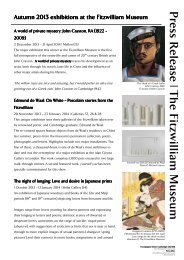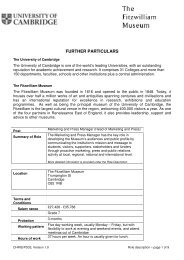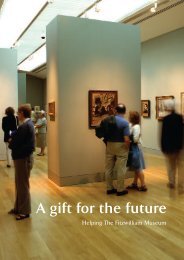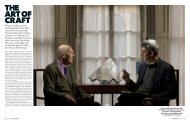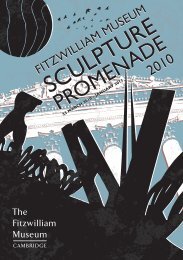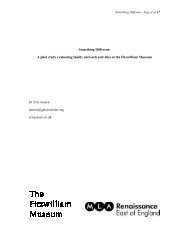The Fitzwilliam Museum - University of Cambridge
The Fitzwilliam Museum - University of Cambridge
The Fitzwilliam Museum - University of Cambridge
You also want an ePaper? Increase the reach of your titles
YUMPU automatically turns print PDFs into web optimized ePapers that Google loves.
Britta New removing the nineteenth century cradle from the central panel <strong>of</strong> the triptych<br />
the Temple and Marriage. Both are animated by the<br />
kind <strong>of</strong> lively, domestic detail which appeals today as<br />
much as it did to viewers in the late fifteenth century.<br />
Although the painting has been ascribed to the<br />
Flemish school, to Brussels and the circle <strong>of</strong> the<br />
‘Master <strong>of</strong> Osroy’ specifically, there is growing<br />
support for an alternative opinion that it originated<br />
in northern France.<br />
One <strong>of</strong> the main problems facing our conservators<br />
was the treatment <strong>of</strong> the panels in the nineteenth<br />
century, when it was common practice to reduce the<br />
thickness <strong>of</strong> the wood behind the layers <strong>of</strong> paint. This<br />
was <strong>of</strong>ten done to correct warping and, as in this case,<br />
was followed by ‘cradling’, or the attachment to the<br />
back <strong>of</strong> the drastically thinned panel <strong>of</strong> a lattice <strong>of</strong><br />
wooden strips to brace it into its flattened position.<br />
Experience has shown that this kind <strong>of</strong> remedial<br />
action <strong>of</strong>ten created more problems than it solved and<br />
our triptych, its original wooden support reduced to<br />
less than I millimetre in thickness, was no exception.<br />
<strong>The</strong> first step, therefore, was to remove the cradling<br />
from all three panels. <strong>The</strong> two wings, because they<br />
are narrower, were relatively straightforward; there<br />
was enough original wood remaining for them to be<br />
self-supporting, although they were fitted eventually<br />
with auxiliary supports which are flexible and can<br />
therefore respond to changes in climate conditions.<br />
<strong>The</strong> larger, central panel presented greater problems.<br />
First <strong>of</strong> all a protective layer <strong>of</strong> Japanese tissue was<br />
attached to the paint surface to preserve it while<br />
three <strong>of</strong> the four boards out <strong>of</strong> which the panel is<br />
constructed were separated along the original<br />
vertical joins. Where boards had been trimmed in<br />
earlier restorations, carefully measured oak fillets<br />
were inserted to rebuild the panel to its original<br />
dimensions. Conservation could then begin on the<br />
painted surface. Fortunately, in spite <strong>of</strong> all <strong>of</strong> that<br />
splitting <strong>of</strong> the wood and flaking <strong>of</strong> the paint which<br />
threatened the survival <strong>of</strong> the image, there were<br />
relatively few actual losses apart from those along<br />
the edges <strong>of</strong> boards. Intervention came in the nick<br />
<strong>of</strong> time in terms <strong>of</strong> preserving the original surface<br />
<strong>of</strong> an object which in spite <strong>of</strong> its resilience was<br />
deteriorating rapidly five centuries after it was made.<br />
Finally, the consolidation completed, all three panels<br />
were reframed without their Victorian corsets and<br />
with sufficient depth in the rebate to allow for their<br />
natural curvature.<br />
Chris Titmus, Hamilton Kerr Institute<br />
41<br />
Conservation



